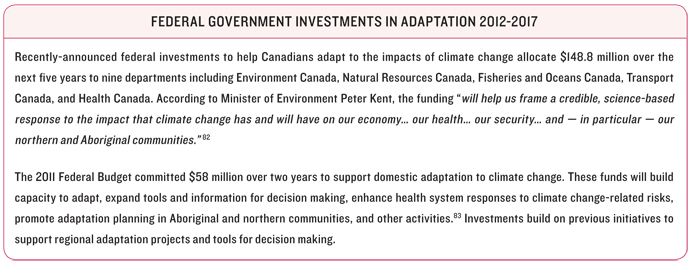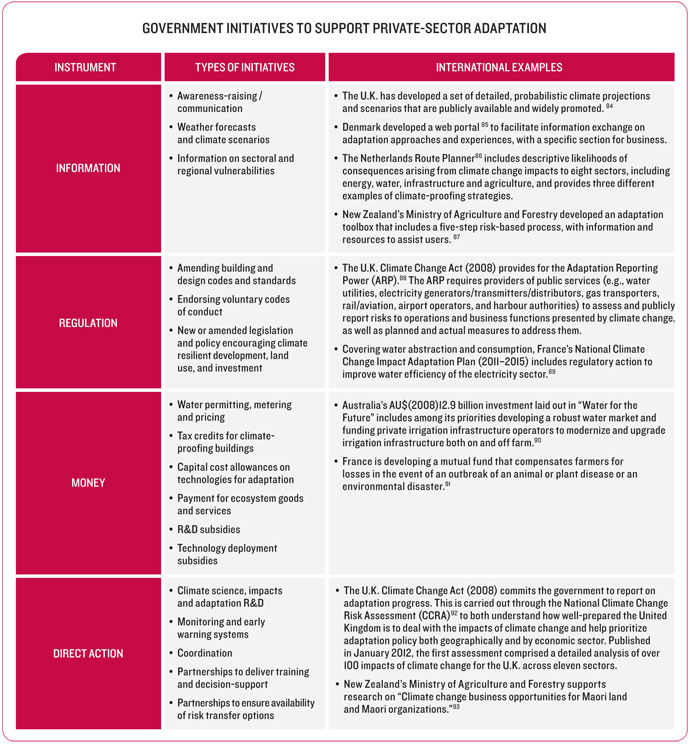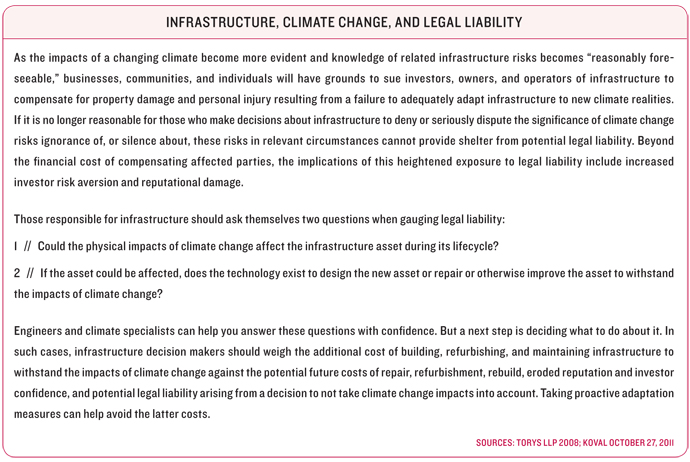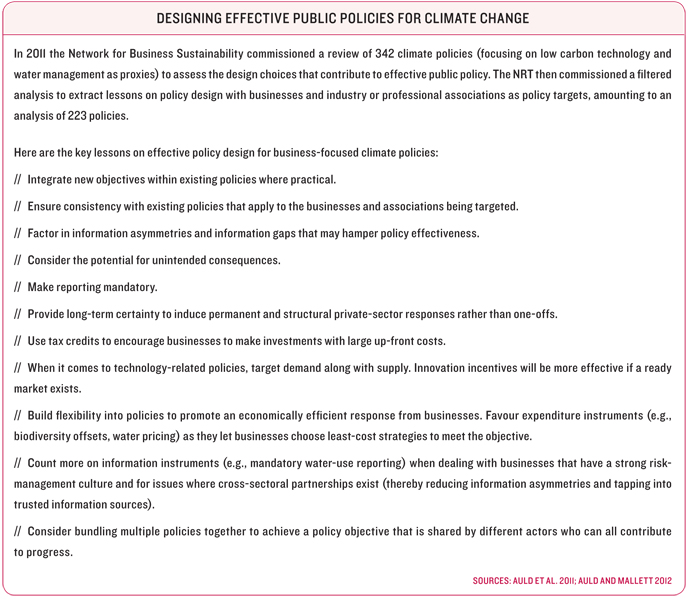4.0 Roles for Governments – Facing the Elements
Preparing for the impacts of climate change before they occur is cheaper than reacting to repeated crises. Governments should remove barriers and create incentives so that businesses are more inclined to proactively adapt. Governments should also ensure the climate resilience of key goods and services like critical infrastructure and ecosystem services for the smooth functioning of businesses and our economy, and step in when businesses’ failure to adapt to a changing climate puts society at risk.
 Businesses in Canada and abroad can take and are taking action to adapt to the risks and opportunities of a changing climate with existing information, tools, and capacity. Government funding for consortia specializing in regionally-relevant research; collection and provision of climate data; support for impacts and adaptation research; and initiatives to raise awareness of future impacts and to develop tools are all public-sector actions that have helped. But should Canadian governments take further action to incent private-sector adaptation, and if so, how? In building climate resilience, what support can Canadian business expect from government? This chapter investigates these questions by first exploring broad government roles in driving business adaptation and then singling out key business barriers that warrant government intervention.
Businesses in Canada and abroad can take and are taking action to adapt to the risks and opportunities of a changing climate with existing information, tools, and capacity. Government funding for consortia specializing in regionally-relevant research; collection and provision of climate data; support for impacts and adaptation research; and initiatives to raise awareness of future impacts and to develop tools are all public-sector actions that have helped. But should Canadian governments take further action to incent private-sector adaptation, and if so, how? In building climate resilience, what support can Canadian business expect from government? This chapter investigates these questions by first exploring broad government roles in driving business adaptation and then singling out key business barriers that warrant government intervention.
4.1 Setting the Stage
Risk management and entrepreneurship come naturally to business and industry, so it’s safe to assume that a degree of private-sector action to reduce risk and seize opportunities of a changing climate will proceed unaided by governments. Unlike measures to reduce GHG emissions, which provide global benefits, benefits from measures that build resilience to physical impacts tend to accrue to those who invest in them. Combined with the mounting sources of information on climate change, its impacts, and options to adapt, the locality of physical impacts and the associated potential for loss or gain will likely provide sufficient motive for many businesses to invest in adaptive measures.
However, spontaneous responses alone may not be enough. In particular, the literature and our own research suggest shortcomings in the ability and inclination of businesses to make adjustments today to prepare for future climate realities. In many instances, acting in advance to prepare for the impacts of climate change before they occur is cheaper than reacting to crisis situations, so governments have a role to play in removing barriers and creating incentivest that encourage businesses to take a proactive stance. Governments also have a role to play in protecting and investing in capital goods and services — such as infrastructure systems and ecological goods and services — that are essential to our continued economic prosperity. Both roles are justified on grounds of economic efficiency.77 Finally, the prospect of significant threats to the environment or human health from businesses’ failure to adapt to a changing climate warrants government intervention in defence of the public good.
Governments in Canada and abroad acknowledge the importance of private-sector action to adapt to climate change, but few have implemented targeted policy measures. Several government strategies or plans focus on assessing sectoral vulnerabilities and encouraging collaboration. For example, British Columbia’s 2010 Adaptation Strategy provides for the completion of climate change assessments for key sectors, and the first such assessment is underway with the agriculture sector.78 Denmark’s 2008 National Adaptation Strategy emphasizes impacts and adaptation research, information provision, and inter-departmental collaboration for eleven priority sectors, including buildings and construction, water, energy supply, insurance, fisheries, and agriculture and forestry.79
Among national governments Australia and the United Kingdom are, perhaps, two exceptions. The Australian government is fulfilling its role in enabling action by businesses and communities to adapt by adjusting existing institutions and policy frameworks. For example, in collaboration with the Murray-Darling Basin state authorities, the Australian government is amending water pricing mechanisms and setting new water-use limits.80 The U.K. Climate Change Act (2008) grants government the power to mandate corporations providing public services like water, electricity, fuel transportation, airport and harbour operators to assess and disclose the risks of climate change, as well as related management actions.81 In addition to risk reduction, the U.K.’s approach seeks to exploit commercial opportunities in climate change adaptation (see Box 5).
BOX 5

4.2 The role of government
Table 2 summarizes policy measures that governments can employ to help businesses and industry adapt, including examples of their current international application. Relative to the potential scope of policy intervention, the examples we found are few, and even less is known about their effectiveness. This is a sign of two factors: the level of maturity of private-sector adaptation as a policy issue and the challenge of distinguishing between efforts to promote adaptation to climate change and efforts to promote sustainable development, sustainable resource management, and good risk management overall.
Although not designed to address the impacts of climate change, a number of regulations in Canada mandate actions that could yield adaptation benefits. Environmental regulations such as the Canadian Environmental Assessment Act (CEAA) and the Québec Water Act provide good examples of these. Despite enforcement challenges, anecdotal accounts from NRT stakeholders lead us to conclude that environmental assessments and other environmental permitting requirements will only grow in importance as a mechanism to drive business adaptation. Codes and standards, land-use planning and permitting at the provincial, territorial, and municipal level are also germane, in that they influence siting (e.g., New Brunswick’s Coastal Planning Policy and Halifax’s harbour front plan) and operational decisions (e.g., requirements for infrastructure engineering design, requirements to manage storm water, and building permits) of business.
Adjustments to existing policies and creation of new ones to support proactive adaptation by business and industry will be multi-faceted. Unlike GHG emissions mitigation, relying on one major policy instrument, such as an economy-wide carbon price, is hardly appropriate for the context and site-specificity implicit in adapting to the impacts of climate change. Sectoral adaptation priorities at the national level are not obvious either. Industry sectors already exposed to the early impacts of climate change, including forestry, agriculture, and tourism, are known to be vulnerable, but all industry sectors are implicated and their exposure to climate change risk and economic importance is regionally variable. Finally, evaluating adaptation success won’t be as straightforward as collecting and analyzing economic performance and emissions data. Canadian governments and researchers have only recently started to investigate how to set targets for adaptation and how to measure progress.[u]
The message from Canadian business and industry to us was clear: at this stage, government roles lie in creating an enabling environment for private sector-action rather than introducing new requirements to adapt.[v] The federal government has not yet clarified to Canadians its roles and responsibilities on climate change adaptation or announced what regulatory or policy reforms could ensue. Canadian governments have had limited dialogue to date with the private sector on adaptation as a policy and business issue. However, the federal government has recently committed to new investments in domestic adaptation programming to build Canadians’ capacity to adapt to a changing climate that could have some benefits for business (for example, see Box 6).
BOX 6

So, what policy interventions to support business adaptation should Canadian governments prioritize today? And, how should Canadian governments work with others to remove barriers and create the conditions for investment in adaptive measures by business in anticipation of future physical impacts? The needs and barriers faced by business in managing climate change risks and opportunities and in building long-term resilience form the launching point for these discussions.
TABLE 2

4.3 KEY BARRIERS TO ACTION IN CANADA
Our research and convening activities revealed several factors standing in the way of business action to adapt to a changing climate.[w] Some barriers are best dealt with by businesses alone. However, case study businesses and firms participating in scoping research and NRT events clearly articulated a need for support from government and others to overcome five key barriers:
// VULNERABILITY THROUGH INTERDEPENDENCIES: Several businesses profiled in this report have suffered climate-related damages beyond their direct control, e.g., consequences from failure of built infrastructure or transport systems during extreme weather events and idle production when critical inputs were adversely affected by climate conditions elsewhere. Diversifying and strengthening supply chains and distribution channels can help, but cannot completely manage these risks. Regardless of businesses’ individual efforts to plan and protect themselves from the impacts of climate change, vulnerable infrastructure makes them vulnerable too. Businesses expect governments to protect, invest in, and adjust the policy environment governing critical infrastructure systems to ensure their continued performance in a changing climate.
// LACK OF POLICY AND REGULATORY SUPPORT: Canada currently lacks a consistent, clear national signal to highlight the importance to business of assessing and managing risks of a changing climate. Climate change risk management by business is, for the most part, optional. Perspectives on the need for a national framework, for example, differ, but perceived benefits include coordination across regions, sectors, and levels of government, and clarity on roles and responsibilities. A national framework, however, should help — not hinder — decentralized efforts in areas such as land-use planning, water, and infrastructure. Existing regulations that fail to account for climate change could constrain businesses’ action to prevent climate-related damage in the future. In the forestry industry, for instance, reduced water consumption and increased process efficiency can help offset operational risks in times of water scarcity (and also benefit other water users) but could lead to increased discharge of effluent concentrations, putting a business at risk of non-compliance. In other regulated sectors, the inability to pass costs on to customers creates a bias against capital investments now that would lead to longer-term benefits and reduced costs in the future.
// GAPS IN INFORMATION AND TOOLS FOR DECISION SUPPORT: Although needs and priorities vary by industry sector, geographic location, and end-use, a widespread perception exists of inadequacies in the availability of and access to climate change information.[x] Perceived inadequacies lead to a “wait-and-see” attitude that constrains decision making on adaptation. We note four specific challenges: confidence in climate projections and related challenges in choosing projections as inputs for impact assessment; availability of climate projections at meaningful scales for business decisions (high spatial resolution, short time-frames); climate change information in formats, language, and locations that are accessible by business; and availability of practical tools and guidance to help assess climate change risk for business and appraise options to adapt.
// LACK OF FINANCIAL INCENTIVES FROM GOVERNMENT: Businesses respond to government signals. Currently, businesses don’t have access to financial incentives from government for assessing or managing climate change risks, other than the economic benefits of improved risk management. Yet some adaptive measures could require considerable capital or operational expenditure (e.g., upgrading building foundations) and others provide public benefits (e.g., actions to enhance forest resilience). The lack of incentives, combined with the difficulty of passing costs on to customers in highly regulated sectors, puts those businesses that invest in adaptation at a perceived disadvantage.
// LACK OF SHAREHOLDER AND IN VESTOR COMMITMENT AND SUPPORT: If key capital market players prioritize and buy into the importance of investing now to avoid potential losses later, so too will businesses. Although public acknowledgement of climate change risk and adaptation as a material issue for investor decisions could well increase[y], a focus on short-term value creation is likely to prevail. This puts the onus on businesses to demonstrate the value of long-term adaptation to investors.
4.4 OUTLINING PRIORITIES FOR MOVING FORWARD
We prioritize four high-level goals for government action to enable business adaptation. These goals are based on our diagnosis of the main barriers to business adaptation in Canada today and direct feedback from businesses on how governments could best support action.
// Tailor climate change information for application by business.
// Augment investor information through better corporate disclosure.
// Enhance the resilience of critical infrastructure.
// Prepare now for future policy innovation.
Tailor climate change information for application by business
An effective and efficient adaptation approach for businesses is to apply climate change information to operational and strategic decisions using management systems and frameworks already familiar to business.[z] And as this report demonstrates, leading businesses are already doing so by making good use of the climate change information generated by federal, provincial, and territorial initiatives and funding, among others. For example, businesses combine the observed climate data with their internal records (site-specific maintenance costs, for example) to analyze their own vulnerability to climate-related hazards. Businesses profiled in this report have also benefited significantly from collaborative partnerships with academic researchers, specialist organizations, and industry peers through regional climate service centres (e.g., Ouranos consortium in Québec and the Pacific Climate Impacts Consortium in British Columbia). For the most part, businesses are taking this on voluntarily, although some have been prompted by environmental regulations.94
However, the integration of climate change information into business risk management and planning is far from mainstream. Until recently, information providers in Canada saw limited demand from the private sector for specific information resources for their climate change adaptation efforts. Comprehensive assessments of data and information needed or used by Canadian industry sectors have not taken place. Yet we know that strategic business decisions are being made every day in Canada that have long-term implications and that are subject to risks from changing climate. We also know that uncertainty in the precise timing and nature of climate change impacts is hardly a valid reason to ignore these risks. Needs and end-uses for climate change information are diverse within and across industry sectors (Table 3 contains examples), requiring tailored approaches to turn data, information, and knowledge into action. Translating climate change information into business risks, and in particular expressing those risks in financial terms, is a challenge for many businesses.
Provision of information and tools to aid decision making across regions and sectors is core to several adaptation strategies of Canadian governments. It’s something governments are already committed to doing. For example, federally, Natural Resources Canada’s new phase of adaptation programming promises to get information into the hands of natural resource sectors to support competitiveness.95 Since abundant information to aid adaptation efforts already exists, collaboration is key to identifying practical and cost-effective approaches to leverage the resources we already have to make good decisions under climate uncertainty.
Part of this lies in recognizing that putting information and tools out there is insufficient to shift behaviour. The U.K.’s experience is worth noting here. Robust and detailed climate projections and scenarios have been available to the U.K. public for some time now, but their uptake by British industry has been limited. In 2010 the Confederation of British Industry recommended that “[t]he UK Climate Projections should be packaged as a range of more tailored offerings…for non-climate-specialists.”96 For Canadian businesses to continue improving the quality of their risk models and be able to identify effective and economically-sound adaptive measures, addressing barriers to information access and gaps in capacity to apply and integrate climate change information into routine business procedures are all important.
TABLE 3

Augment investor information through better corporate disclosure
Publicly listed companies must disclose material information to investors through their continuous disclosure obligations under Canadian securities laws, including material risks of a changing climate and related management strategies. The Canadian Securities Administrators’ (CSA) National Instrument 51-102 Continuous Disclosure Obligations requires Canadian companies (other than investment funds) to file a completed Management’s Discussion & Analysis (MD&A) form with their annual and interim financial statements. In the MD&A, companies must disclose material information. Companies must also file an annual information form (AIF), which includes a statement of the risk factors relating to its business, including “environmental and health risks” and “any other matter that would be most likely to influence an investor’s decision to purchase securities of [the] company.”101
Companies know they must disclose material risks and information but can struggle to determine exactly which risks meet this threshold and how they should be disclosed. To help companies comply with the law, the CSA published its Environmental Reporting Guidance102 in October 2010, eight months after the Commission Guidance Regarding Disclosure Related to Climate Change was published by the U.S. Securities and Exchange Commission.103 Among other aspects, the CSA guidance asks companies to determine how they are likely to be “affected by physical risks of environmental matters, such as the impacts of […] changing weather patterns and water availability.”104 Implicit in this guidance is an acknowledgement that companies still fail to meet their disclosure obligations around climate change, despite their legal requirements and investors’ incipient concerns over climate change impacts and adaptation.105
Our analysis of 2010 annual securities filings of 35 issuers across seven industries revealed limited climate change disclosure, including of physical climate change risk and adaptation strategies. Even when issuers discuss how severe weather events or water availability affect their business operations, they rarely link these to broader climate trends, despite the weight of scientific evidence on current and projected climate change impacts. In some cases, businesses acknowledge climate change-related risks in voluntary reports, providing only minimal or boilerplate disclosure in their mandatory reports.
Limited climate change disclosure in financial filings among the Canadian companies assessed could simply reflect management’s determination that climate change impacts aren’t a material business risk. However, disclosure of risks to business operations from severe weather occurred at higher rates in 2010 annual filings than even as recently as 2008. Also, physical risks from climate change are unlikely to affect only a single or handful of businesses in a particular sector. For example, in the transportation sector, if climate change has the potential to increase the frequency of adverse weather events for one railway business it likely warrants mention for others of similar size and geographic location — unless significant differences in risk controls and governance among businesses existed. It’s possible that some businesses narrowly focus their materiality analysis on regulatory risks from GHG emissions mitigation policy and fail to incorporate knowledge of operational, financial, and strategic risks posed by the impacts of climate change.
Insufficient disclosure presents information challenges for investors and enforcement questions for securities regulators. For investors to make informed decisions about the risks a business faces from a changing climate (let alone attempt to influence such positions), businesses must disclose these risks and their management strategies to investors in their mandatory financial filings. Relative to risks from GHG emissions mitigation policy, risks from future physical impacts of climate change are becoming increasingly certain, at least in a directional sense.106 A rise in demand for greater disclosure on adaptation by the investing public and other stakeholders is soon to follow. Limited recognition of material risks from a changing climate by the insurance companies assessed is a particular concern since failure to incorporate climate change risk in underwriting could have knock-on implications for the performance of investments.107
Enhance the resilience of critical infrastructure
Businesses depend on networks of public and private physical assets to deliver goods and services reliably. Infrastructure providers include local, regional, and national actors — among them departments within federal, provincial, territorial, and municipal governments, as well as Crown corporations and privatesector providers of energy (e.g., pipelines, electricity generation, transmission and distribution), transport (rail and ports) and telecommunications.
Disruptions in service have cascading implications for businesses, capital investment, and the economy, so it’s important that infrastructure operators — regardless of ownership — take steps to assess infrastructure risks from climate change and address any deficiencies. This is particularly key for “critical infrastructure” where society risks paying the costs of infrastructure failure or service disruptions. Consider the ripple effects of a 2011 heat wave in the U.S., where temperatures in several states exceeded 40°C.108 The heat caused significant stress on electricity transmission and distribution systems. Twenty-five thousand households and businesses in four Detroit townships suffered the consequences of rolling blackouts.109 The 2005 Finch Avenue washout in Toronto led to disruptions of natural gas, electricity, telecommunications, and water and sewer service delivery. This one storm resulted in $(2005)547 million in costs associated with settling insurance claims (e.g., damage to homes from sewer backups) and bringing the city’s infrastructure back in service.110
Several complementary mechanisms in Canada can help build the climate resilience of our key infrastructure systems.[aa] The National Strategy for Critical Infrastructure sets out an approach to manage the risk exposure of critical infrastructure to natural, intentional, and accidental hazards111 and risks from a changing climate fit that scope. Codes, standards, and related instruments (CSRIs) govern all new infrastructure design and construction, and engineers and architects must adhere to CSRIs in their professional practice. CSRIs are evolving to account for changing climate conditions, but these updates wouldn’t apply to existing infrastructure, and it could well take over a decade to significantly change new design and construction practices. The NRT’s True North: Adapting Infrastructure to Climate Change in Northern Canada discussed some of the shortcomings of CSRIs as mechanisms to facilitate adaptation.112 To complement CSRI updates, short-term, site-specific initiatives to assess and manage climate change risks to infrastructure are necessary and are taking shape. Supported by federal funding and expertise, Engineers Canada has developed an infrastructure assessment protocol — referred to as the Climate Risk Protocol — that several municipalities in Canada have used to determine the vulnerability of new and existing infrastructure to the changing climate. International application of this protocol is also occurring.
But significant hurdles stand in the way of systematically assessing and managing climate change risk to publicly and privately owned infrastructure — to our economic peril. We note three issues in particular. First, infrastructure operators may defer action on longer-term issues like climate change in favour of more immediate cost savings. Second, neither public- nor private-infrastructure owners have specified account ability for adaptation among operational teams to efficiently integrate risk assessment and management within annual maintenance, operational, and capital planning. Third, the potential for legal liability, in some cases, acts as a deterrent to identify infrastructure vulnerabilities in the first place (see Box 7).113
BOX 7

Prepare now for future policy innovation
Adapting to a changing climate is a long-term process. This report, however, largely focuses on the importance of accelerating private-sector action to adapt to the changes already locked-in to the global climate system. Climate futures are inherently uncertain, though, with scientific evidence raising the prospect of needing to adapt to as much as a 4°C world over this century.114 This has important implications for decisions and investments with long lifetimes, such as major economic decisions involving infrastructure development and land-use changes. The possibility of more intense and rapid changes in climate than science can predict also raises questions about our continued reliance on certain business models (e.g., the viability of justin-time practices) or on goods and services whose access we take for granted (e.g., air conditioning or mountain snowpack as stored energy).
BOX 8

Long-term planning is, at the best of times, a challenge for decision makers in public and private sectors alike. But the combination of scientific uncertainty and the potential for surprises makes long-term planning all the more necessary.115 Some of the most significant requirements of government and business will involve setting long-term goals, building the evidence base to inform adjustments in existing policy frameworks or development of new policy, and making tough choices to account for climate change–related shifts in demand and supply of key goods and services (see Box 8 for design considerations for climate policies). Long-term signals from governments will help encourage investment in adaptive measures and establish a level playing field for competitive business success.
[t] For our purposes, “incentives” broadly refer to resources or institutions that encourage or discourage certain types of behaviour. Incentives can include relevant information, price signals, regulations, standards, and financial rewards or penalties. Provision of or access to these incentives can be by design or unintentional.
[u] For example, in March 2012, NRT staff participated in a national workshop on measuring progress on adaptation in Canada organized by Ouranos and Natural Resources Canada. The objectives were to: “initiate a discussion on the topic in Canada; clarify what our objectives are in measuring adaptation; and identify the types of guidelines, tools and data required.”
[v] This direction came from discussions with NRT’s advisory committee to this project and other sources (Deloitte 2011; National Round Table on the Environment and the Economy Secretariat 2011).
[w] See Appendix 6.1 for a full list.
[x] “Climate change information” is a catch‐all term that includes databases of climate variables, both average and extreme, climate projections and their interpretation, climate change impacts and adaptation research, and analytical guidance and tools to assess business impacts, develop, and select response options.
[y] There is some evidence of this among Canadian institutional investors: the British Columbia Investment Management Corporation (bcIMC) joined the Ceres Investor Network on Climate Risk (Ceres 2010b) and bcIMC along with the Ontario Municipal Employees Retirement System (OMERS) participated in the development a recent Mercer report titled Climate Change Scenarios — implications for Strategic Asset Allocation (Mercer 2011).
[z] Enterprise risk management, business continuity, environmental management, and quality management systems, are a few examples of the management systems that can help translate knowledge of climate change risks and opportunities into strategies that preserve and create value.
[aa] Analysis in this section comes from D.J. Danyluk Consulting Ltd. 2012. The consultant’s report is available from the NRT upon request.
[77] Hallegate, Lecocq, and de Perthuis 2011
[78] J. Fraser BC Ministry of Environment 2011
[79] The Danish Government 2008
[80] Australian Government Department of Climate Change and Energy Efficiency 2010
[81] United Kingdom 2008; Environment Agency ND
[82] Environment Canada November 8, 2011
[83] Government of Canada 2011
[84] Department for Environment Food and Rural Affairs ND
[85] Information Center for Climate Change Adaptation – Danish Ministry of the Environment – Danish Nature Agency ND
[86] Leven met water 2007
[87] New Zealand Ministry of Agriculture and Forestry 2010
[88] Environment Agency ND
[89] Ministère de l’écologie du développement durable des transports et du logement 2011
[90] Minister for Climate Change and Water Senator, the Honorable Penny Wong 2008; Department of Sustainability Environment Water Population and Communities ND
[91] Ministère de l’écologie du développement durable des transports et du logement 2011
[92] Department for Environment Food and Rural Affairs 2010
[93] New Zealand Ministry of Agriculture and Forestry 2011
[94] National Round Table on the Environment and the Economy 2012
[95] O’Dea March 28, 2012 – Natural Resources Canada presentation on the Adaptation Platform
[96] CBI 2010
[97] Odendahl October 27, 2011; UNEP Finance Initiative and Sustainable Business Institute 2011
[98] National Round Table on the Environment and the Economy 2012 personal communication P. Steenhoff, Canadian Standards Association
[99] National Round Table on the Environment and the Economy 2012 Murdock 2010
[100] Canadian Home Builders Association 2011;personal communication P. Steenhoff, Canadian Standards Association
[101] Ontario Securities Commission 2006
[102] Canadian Securities Administrators 2010
[103] Securities and Exchange Commission 2010
[104] Canadian Securities Administrators 2010
[105] Investor Network on Climate Risk ND; see for example Shareholder Association for Research and Education ND
[106] Reidel 2011
[107] Leurig 2011
[108] Harris 2011
[109] CBS 2011
[110] MacLeod and City of Toronto December 2, 2010
[111] Government of Canada 2009
[112] National Round Table on the Environment and the Economy 2009
[113] National Round Table on the Environment and the Economy 2009
[114] Smith et al 2011
[115] Eakin et al 2009
























